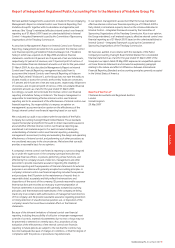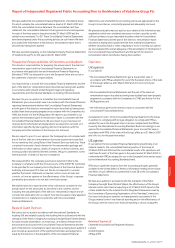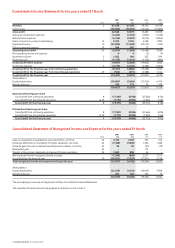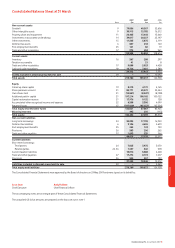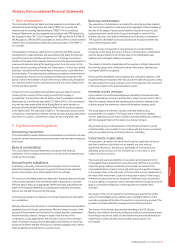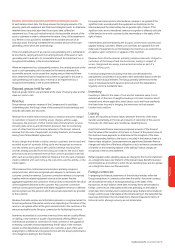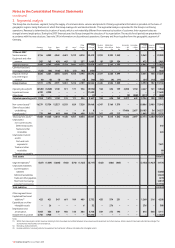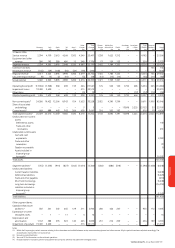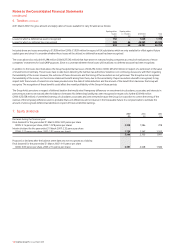Vodafone 2007 Annual Report Download - page 99
Download and view the complete annual report
Please find page 99 of the 2007 Vodafone annual report below. You can navigate through the pages in the report by either clicking on the pages listed below, or by using the keyword search tool below to find specific information within the annual report.
Vodafone Group Plc Annual Report 2007 97
Financials
Property, plant and equipment and finite lived intangible assets
At each balance sheet date, the Group reviews the carrying amounts of its
property, plant and equipment and finite lived intangible assets to determine
whether there is any indication that those assets have suffered an
impairment loss. If any such indication exists, the recoverable amount of the
asset is estimated in order to determine the extent, if any, of the impairment
loss. Where it is not possible to estimate the recoverable amount of an
individual asset, the Group estimates the recoverable amount of the cash-
generating unit to which the asset belongs.
If the recoverable amount of an asset or cash-generating unit is estimated to
be less than its carrying amount, the carrying amount of the asset or cash-
generating unit is reduced to its recoverable amount. An impairment loss is
recognised immediately in the income statement.
Where an impairment loss subsequently reverses, the carrying amount of the
asset or cash-generating unit is increased to the revised estimate of its
recoverable amount, not to exceed the carrying amount that would have
been determined had no impairment loss been recognised for the asset or
cash-generating unit in prior years. A reversal of an impairment loss is
recognised immediately in the income statement.
Disposal groups held for sale
Disposal groups held for sale are stated at the lower of carrying value and fair
value less costs to sell.
Revenue
Group revenue comprises revenue of the Company and its subsidiary
undertakings plus the Group’s share of the revenue of its joint ventures and
excludes sales taxes and discounts.
Revenue from mobile telecommunications comprises amounts charged
to customers in respect of monthly access charges, airtime usage,
messaging, the provision of other mobile telecommunications services,
including data services and information provision, fees for connecting
users of other fixed line and mobile networks to the Group’s network,
revenue from the sale of equipment, including handsets, and revenue
arising from Partner Market agreements.
Access charges and airtime used by contract customers are invoiced and
recorded as part of a periodic billing cycle and recognised as revenue
over the related access period, with unbilled revenue resulting from
services already provided from the billing cycle date to the end of each
period accrued and unearned revenue from services provided in periods
after each accounting period deferred. Revenue from the sale of prepaid
credit is deferred until such time as the customer uses the airtime, or the
credit expires.
Other revenue from mobile telecommunications primarily comprises
equipment sales, which are recognised upon delivery to customers, and
customer connection revenue. Customer connection revenue is recognised
together with the related equipment revenue to the extent that the
aggregate equipment and connection revenue does not exceed the fair value
of the equipment delivered to the customer. Any customer connection
revenue not recognised together with related equipment revenue is deferred
and recognised over the period in which services are expected to be provided
to the customer.
Revenue from data services and information provision is recognised when the
Group has performed the related service and, depending on the nature of the
service, is recognised either at the gross amount billed to the customer or the
amount receivable by the Group as commission for facilitating the service.
Incentives are provided to customers in various forms and are usually offered
on signing a new contract or as part of a promotional offering. Where such
incentives are provided on connection of a new customer or the upgrade of
an existing customer, revenue representing the fair value of the incentive,
relative to other deliverables provided to the customer as part of the same
arrangement, is deferred and recognised in line with the Group’s performance
of its obligations relating to the incentive.
For equipment sales made to intermediaries, revenue is recognised if the
significant risks associated with the equipment are transferred to the
intermediary and the intermediary has no general right of return. If the
significant risks are not transferred, revenue recognition is deferred until sale
of the handset to an end customer by the intermediary or the expiry of the
right of return.
Intermediaries are incentivised by the Group to connect new customers and
upgrade existing customers. Where such incentives are separable from the
initial sale of equipment to an intermediary, the incentive is accounted for as
an expense upon connection, or upgrade, of the customer.
Revenue from other businesses primarily comprises amounts charged to
customers of the Group’s fixed line businesses, mainly in respect of
access charges and line usage, invoiced and recorded as part of a
periodic billing cycle.
In revenue arrangements including more than one deliverable, the
arrangement consideration is allocated to each deliverable based on the fair
value of the individual element. The Group generally determines the fair
value of individual elements based on prices at which the deliverable is
regularly sold on a standalone basis.
Inventory
Inventory is stated at the lower of cost and net realisable value. Cost is
determined on the basis of weighted average costs and comprises direct
materials and, where applicable, direct labour costs and those overheads
that have been incurred in bringing the inventories to their present
location and condition.
Leasing
Leases are classified as finance leases whenever the terms of the lease
transfer substantially all the risks and rewards of ownership of the asset to
the lessee. All other leases are classified as operating leases.
Assets held under finance leases are recognised as assets of the Group at
their fair value at the inception of the lease or, if lower, at the present value of
the minimum lease payments as determined at the inception of the lease.
The corresponding liability to the lessor is included in the balance sheet as a
finance lease obligation. Lease payments are apportioned between finance
charges and reduction of the lease obligation so as to achieve a constant rate
of interest on the remaining balance of the liability. Finance charges are
recognised in the income statement.
Rentals payable under operating leases are charged to the income statement
on a straight line basis over the term of the relevant lease. Benefits received
and receivable as an incentive to enter into an operating lease are also spread
on a straight line basis over the lease term.
Foreign currencies
In preparing the financial statements of the individual entities within the
Group, transactions in currencies other than the entity’s functional currency
are recorded at the rates of exchange prevailing on the dates of the
transactions. At each balance sheet date, monetary items denominated in
foreign currencies are retranslated at the rates prevailing on the balance
sheet date. Non-monetary items carried at fair value that are denominated in
foreign currencies are retranslated at the rate prevailing on the date when fair
value was determined. Non-monetary items that are measured in terms of
historical cost in a foreign currency are not retranslated.




